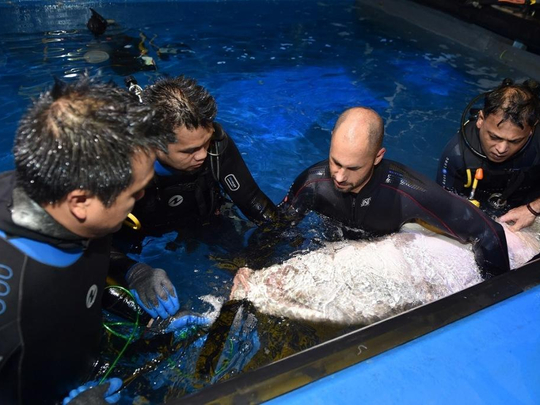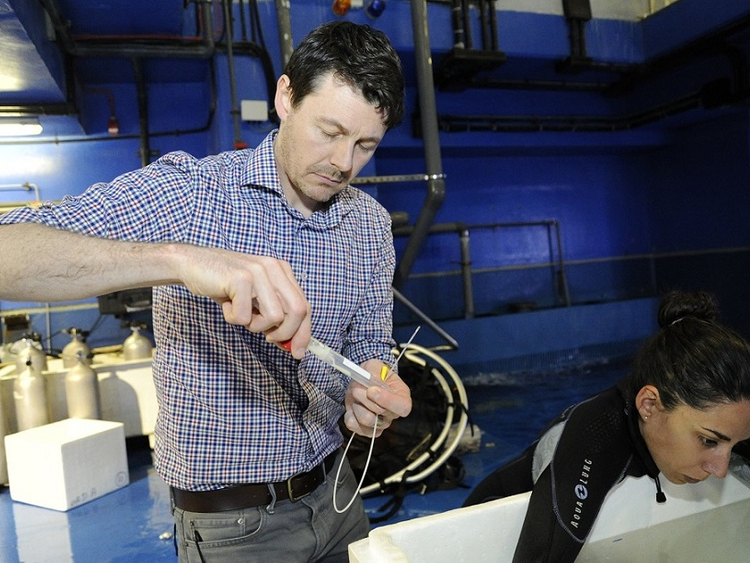
Dubai: All hope is not lost to save endangered Sand Tiger Sharks from extinction after a ground-breaking discovery that an Australian scientist brought to the Dubai Aquarium and Underwater Zoo.
For the first time, a breeding programme using artificial insemination will be initiated on Sharks at the Dubai Aquarium & Underwater Zoo and a gene bank will be used to hold the genes of Sand Tiger Sharks and protect their existence for more than 100 years.
The aquarium currently houses the largest population of Sand Tiger Sharks, which have been listed on the red list of threatened species by the International Union for Conservation of Nature.
Shark conservation using Artificial Insemination (AI) is a major step being taken for the Sand Tiger Shark whose stocks have dropped to an estimated 1,500 on the Australian East Coast and is expected to be extinct in the next three decades, said Dr Jon Daly, a scientist and research consultant who has been studying ways to save the population of sharks using AI.
“The reason for the declining number of Sand Tiger Sharks is linked to the fact that they were either hunted for causing many shark attacks and also for being captured by fishermen. They also have very slow reproductive cycles (of two years) and during pregnancy, the pups hunt each other in the womb and then only one or two are born,” he said.
Through this technology, Dr Daly said he will be able to take the shark’s sperm, freeze it in liquid nitrogen at a temperature of -196 degrees Celsius, store it and then reactivate it to inseminate it in female sharks.
“To support the research programme, the first dedicated lab Cryopreservation Facility in the world to developing sharks with AI has been built here. It will help us monitor Sand Tiger Sharks’ reproductive cycles and hormones using ultrasound technology and track sperm from male sharks,” he said.
The second big part is storing the genetics which allows us to also keep an insurance bank of shark DNA that could be used in the future to prevent their extinction, he said.
“This ensures that if the population goes down further, there is the knowledge to go out in the wild and save them.”
The AI technology is not new, said Paul Hamilton, General Manager and Curator of the Dubai Aquarium and Underwater Zoo, “but it has been applied mostly on traditional species like land mammals but never on sharks. Only two years ago did Dr Daly succeed in making the birth of the first Bamboo shark possible through AI.”
“Intervention of AI is done when hope is lost and we have only one last card to play before the species is gone. We are in a critical age and no one is developing AI on sharks and this is why we decided to start this in collaboration with SEA LIFE Melbourne Aquarium. It’s a long-term programme and the information we collect will become of use for people dealing with the wild population of sharks.”
The programme, he said, will help strengthen awareness about conservation issues with Sand Tiger Sharks.
During the announcement of the breeding programme, Hamilton also announced two new educational tours the aquarium launched for visitors. The researcher and explorer tours will provide visitors with insights into the operations of the Dubai Aquarium and Underwater Zoo.
Conservation
Similar assisted reproduction programmes have been initiated successfully for the conservation of Pacific White-Sided Dolphins, Bottlenose Dolphins, Spanish Ibex, Cheetah and the Giant Panda.
Efforts have also been made by aquariums on assisted reproduction of egg-laying (oviparous) sharks. This initiative by Dubai Aquarium & Underwater Zoo marks a significant first in a viviparous shark species – one that gives birth to pups.
In addition to raising awareness on the conservation challenges, the programme is a significant step for aquariums worldwide in developing skills to self-sustain populations without having to source from the wild.
Maitha Al Dossari, Chief Executive Officer of Emaar Retail LLC, said: “The launch of this pioneering scientific study in Dubai Aquarium & Underwater Zoo highlights the focus we place on promoting research that will help support endangered species and conserve the environment. A species that is even older than dinosaurs, sharks face innumerable threats across the world. Through a global collaboration, we are putting the spotlight on shark conservation while taking a proactive step to build the population.”
Hamilton added: “We are committed to raising awareness on conservation issues both locally and internationally. It is exciting to take a trailblasing role in the fight to save the Sand Tiger Shark species. We are hopeful that our efforts will set a research benchmark in assisted reproduction of sharks as well as inspire aquariums globally to develop skills to self-sustain their inhabitants. We are confident that the techniques learnt in Dubai Aquarium & Underwater Zoo will eventually be applied to the conservation of sharks worldwide.”
Handling protocols
As part of the programme, Dubai Aquarium & Underwater Zoo expects to set scientific protocols in areas including the handling of Sand Tiger Sharks, sperm collection and its cryopreservation, ultrasound monitoring of female sharks and hormone analysis to assess their reproductive cycle, the artificial insemination process and potential live birth of pups.
A full-fledged cryopreservation lab has already been set up in the Underwater Zoo. The sperm collection will commence in the coming days. It will be stored at the cryopreservation lab until the female Sand Tiger Sharks within Dubai Aquarium are ready for the assisted reproduction.
The project will be led by Research Consultant Dr Jon Daly. In 2013, Dr Daly, together with The Aquarium Vet, Dr Rob Jones, made history at SEA LIFE Melbourne Aquarium with the birth of a Brown Banded Bamboo shark – the first ever shark in Australia to be born via artificial insemination. The pair also rewrote history on a global scale, as this was the first shark pup born via live semen sample transported from one facility to another.
This extraordinary advancement in artificial insemination was part of an ambitious nine-year project into understanding the reproductive behaviours of sharks endemic to Australia, as well as the continuation of Dr Daly’s studies into implementing captive breeding programmes.
These milestones have paved the way for Dr Daly to share his expert knowledge with other aquariums around the world, and as such will be extending his consultancy for a period of three months at Dubai Aquarium & Underwater Zoo. During this time, he will set up an all-new cryopreservation lab as well as continue his curatorial research on the Sand Tiger Sharks.
A full-time research veterinarian is on staff at Dubai Aquarium & Underwater Zoo to oversee the assisted breeding programme and other conservation based initiatives.
Occurring in subtropical and warm temperate oceans, Sand Tiger Sharks have a reproductive cycle of two years with a 9 to 12 month gestation period. While up to 12 embryos are developed in the initial stages, due to uterinecannibalisation, ultimately only two pups are born. As a result, annual rates of population increases are very low.
The assisted breeding programme at Dubai Aquarium & Underwater Zoo will not only potentially help build a population of Sand Tiger Sharks in Dubai, but also contribute to creating the world’s first shark gene bank through the cryopreservation of the shark sperm thus supporting international efforts in sustaining biodiversity.
Educational tours
Two new educational experiences, Researcher and Explorer, have been introduced to provide guests with unique insights into the various operations of Dubai Aquarium & Underwater Zoo.
These tours are part of the enhanced Back of House experience. Those who opt for The Researcher Experience will tour the behind-the-scenes operations of Dubai Aquarium & Underwater Zoo, learning about the unknown facets of the aquatic world including an up-close view of the working laboratory, the adaptations of various species and insight into the multiple onsite breeding programmes.
Additionally, researchers will experience a world’s first through close encounters from an Underwater Observatory, a submerged platform, bringing guests face-to-face with different species. Here, guests may also have the opportunity to feed the fish surrounding them.
The Explorer journey starts with an animated guided tour in a Simulator ride. The narrator is a sea turtle, signaling the conservation efforts led by Dubai Aquarium & Underwater Zoo to preserve sea turtle populations.
From there, Explorers continue their journey on the newly automated glass-bottom boat, cruising with a guide over the aquarium for close encounters with the different species and an opportunity to feed the fish below. Among the aspects covered include the building of Dubai Aquarium & Underwater Zoo, feeding habits of the various species and insights on aquatic ecosystems.
The Ocean School at Dubai Aquarium & Underwater Zoo is opening doors for school children to learn about the assisted breeding programme of Sand Tiger Sharks.
Dubai Aquarium & Underwater Zoo features a 270-degree walkthrough tunnel. Underwater Zoo, located on Level 2 above the main aquarium tank, presents the bio-diversity in different ecological zones including the Rainforest, Coastline and UAE Night Creatures habitats.
Animals
The animals featured here include Humboldt Penguins, Piranhas, Giant Spider Crabs, Small-Clawed Otters, Sea Jellies and Clownfish. Also home to King Croc, one of the world’s largest crocodiles, and his companion; the pair have recently expanded their family and the baby crocs are a popular addition to Dubai Aquarium & Underwater Zoo.














